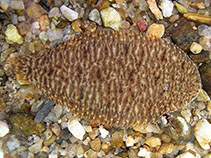| Family: |
Soleidae (Soles) |
| Max. size: |
6.16 cm SL (male/unsexed) |
| Environment: |
benthopelagic; freshwater |
| Distribution: |
Western Pacific: Australia (Queensland). |
| Diagnosis: |
Dorsal soft rays (total): 64-68; Anal soft rays: 48-52; Vertebrae: 35-36. This species is distinguished by the following characters: unbranched rays D 64-68, A 48-52; lateral-line scales 87-97, median 94; abdominal vertebrae 10, total vertebrae 35-36; dorsal pterygiophores anterior to fourth neural spine 7; body depth 2.35-2.70 in SL; head length 4.25-4.85 in SL; eye diameter 6.90-8.25 in HL; stout papillae (not long slender cirri) on anterior edge of snout and ventral edge of head (visible from above on ocular side); scales on blind side of head replaced by cirri anterior to region just posterior to rear of jaws; straight lateral line midlaterally on both sides, forming three branches on ocular side of head: ventral preopercular branch, vertical dorsal branch nearly to base of dorsal fin, and short horizontal continuation of main lateral line; distinct free fleshy sheath on blind side, extending over front half of lower jaw, including lower lip and sometimes part of upper lip when mouth fully closed; ocular side with about 22-26 irregular, mostly discontinuous, transverse brown bands slightly wider than pale interspaces, and three longitudinal rows of 5-6 large diffuse dark brown spots (Ref. 86741). |
| Biology: |
Collected on a broad shallow bank, on coarse sand and gravel substrate, which included numerous fallen leaves and the open shells of freshwater bivalve molluscs. The riverine environment at the type locality is flowing, clear and fresh (being about 5-6 km upstream from the brackish zone), but is clearly subject to tidal influence, with about a 75 cm rise and fall. Environmental parameters at the time of collection (25 November 2006): conductivity 59.6-60.6 μS/cm (approximately 30 ppm), pH 6.8, temperature 29°C, dissolved oxygen 6.5 ppm, and turbidity 0.8 NTU. Stomach contents included fragments of insect larvae and numerous sand grains (Ref. 86741). |
| IUCN Red List Status: |
Data deficient (DD); Date assessed: 14 February 2019 Ref. (130435)
|
| Threat to humans: |
harmless |
Source and more info: www.fishbase.org. For personal, classroom, and other internal use only. Not for publication.

